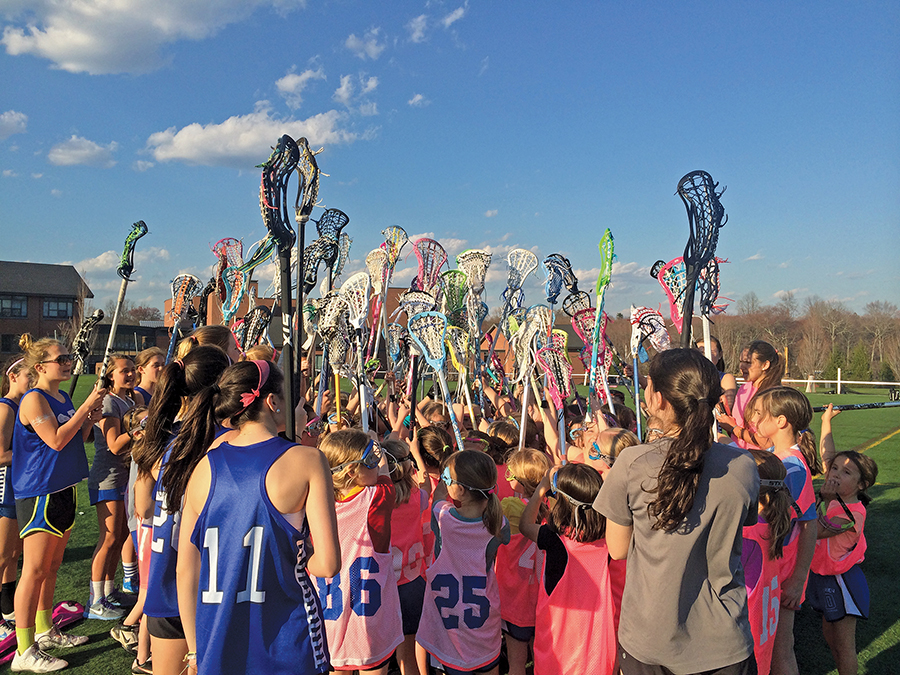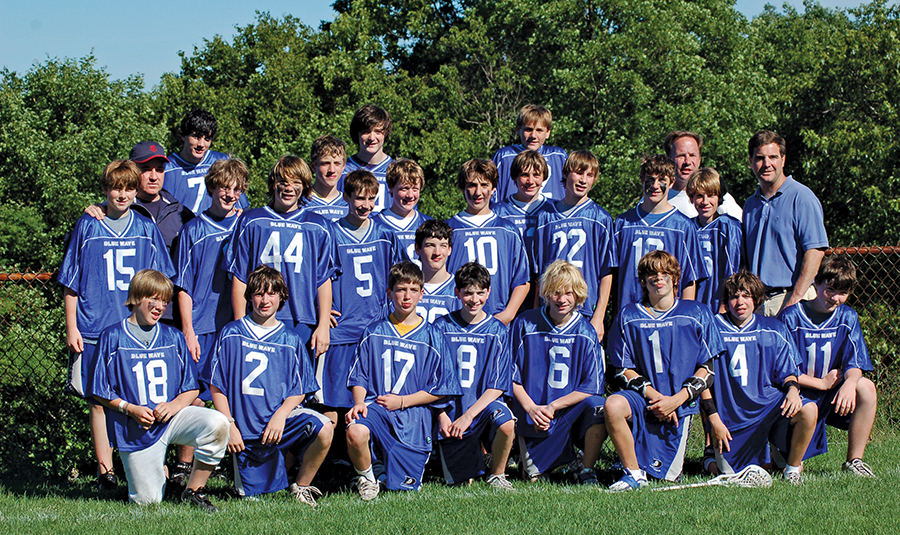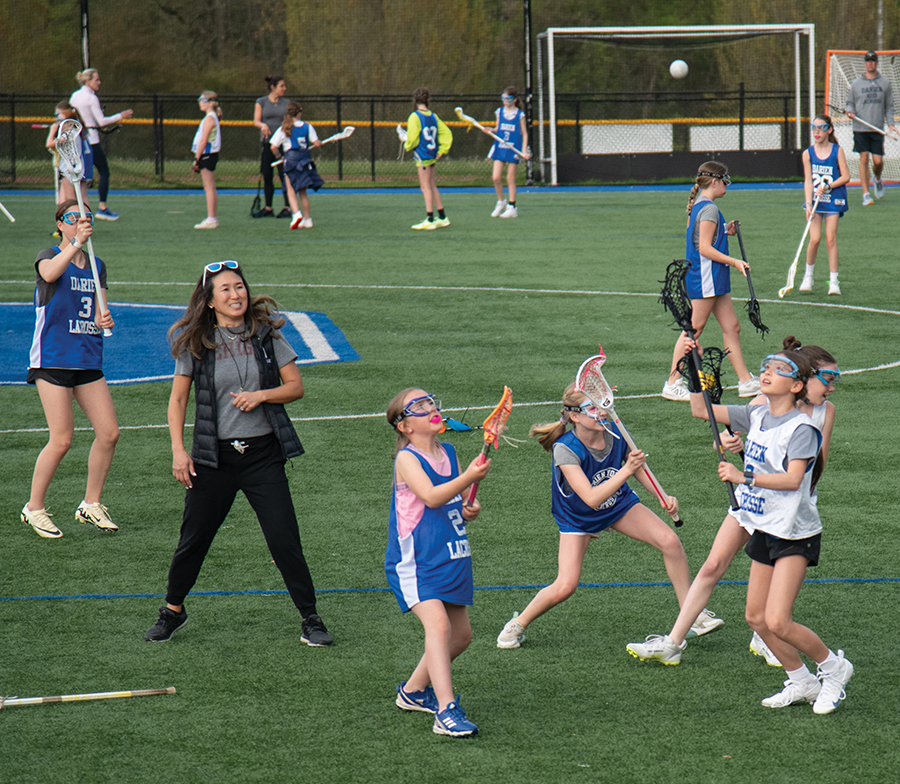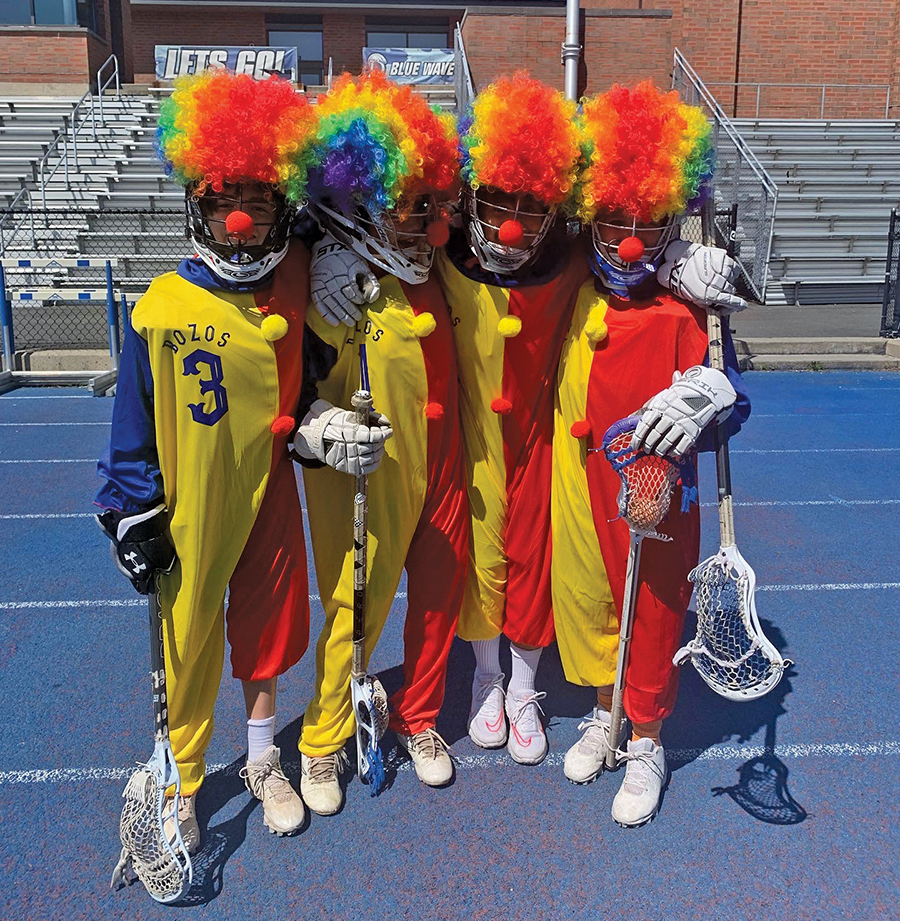By Pamela Dey Vossler
Thank you Palmer’s Market for sponsoring our cover feature.

Blue Wave Buddies | Photograph courtesy DYLax
The tricky thing about telling the story of Darien Youth Lacrosse (DYLax) is how everyone trips over themselves to give credit to someone else for the powerhouse program it has become—copied by towns throughout the northeast who want what we have. With roughly 1,200 kids in grades one through eight participating each year, DYLax is among the largest youth lacrosse programs in the country, a chapter in one of the most storied high school programs in the nation. If you doubt that, visit the high school some weekend morning between early March when DYLax starts and mid-June when it ends and take a look at the hundreds of young kids packing the fields, lacrosse sticks in hand.
The other tricky part about telling this story is you could talk to 20 people about DYLax, only to find you really should be talking to 500 more. So many in this town have had a hand in this.
But it’s not about them, they insist—not the zealots who pieced it together in 2002 when the program we know today launched—with focused intention fueled by a stunning selflessness and knowledge of the game. And not the hundreds of adults who carry it forward now through intention and selflessness of their own.
It’s always been about the kids, they say. Just not in the way you might think.

Coaches from left: Kevin Waldron, Peter Gatt and Jim Raymond with DHS Class of 2011 lacrosse players when they were in 7th grade | Photograph courtesy: Tom Seiler
To call Darien a lacrosse town is to bring to mind records broken, All-Americans minted, titles won. It is to recall the countless players our Hall of Fame high school coaches have sent to top lacrosse colleges and universities. To be fair, perhaps it is also to conjure the kind of eye roll that comes from too much of a good thing – enough already about lacrosse and Darien. We get it. We tend to take the best things in life for granted and miss the layers of good stuff buried within them.
But we do so at our own peril. Because it’s like this: The way to get a town full of All-American lacrosse players who win as much as they do and go on to those top college programs is to start with a youth lacrosse program committed to making sure the last kid on every roster has as much fun with the sport as the first. A youth lacrosse program that:
…cultivates such a love of the game that kids sleep with their stick and carry it everywhere, no matter how many goals they score.
…puts learning over winning and “we” before “me,” at every level.
…gets them young and makes it so fun they come back for more each year.
…makes space for every kid who wants to play, no matter what age or what the future may hold for their extracurriculars.
…keeps kids involved even as they age out—giving them ways to give back and the littles someone to look up to while they’re at it.
…a program that teaches kids things they’ll never get from TikTok, things way beyond how to catch, throw and pick up a ground ball.
That’s what the DYLax founders created when they took over what had been the more limited pay-to-play youth lacrosse program started by Lang Clarke in 1986 with Tom Parnon who assisted as a dedicated volunteer, as did the guys who coached for Lang.
Lang’s program maxed out at 150 kids. His coaches wanted more. All of them had played. Many at top schools. All had fulltime jobs and none even had kids in the program but they loved coaching. They loved the game and they saw the demand for it in town, driven by Coach Jeff Brameier’s quick success after starting the Darien High School (DHS) lacrosse team for boys in 1984, and Coach Lisa Lindley’s after she started the girls team in 1994. Everyone wanted in on what they were doing.
Those coaches were guys like Glen Moore—the first DHS lacrosse player to receive a scholarship to play the sport in college; newly married, no kids, he just wanted to give back to the sport that had given him so much; Rich van den Broek who grew up in Darien, played and coached at Harvard and hadn’t yet moved back to town; Tim West and Andrew Barnard who played with Rich at Harvard and came to practices from Summit, NJ by way of Greenwich where he was working. (He moved to Darien in ‘02.)
They were guys like Mike Connolly, a middie out of Cornell, who moved to Darien in ’95 with his wife and kids and started coaching for Lang shortly thereafter, fitting it in around his daily commute to downtown Manhattan.
According to Rich—who gave more than 20 years to youth lacrosse in Darien, Gary McCarthy, the first president of DYLax—a standout player at Colby, and others, Mike was the true architect of DYLax. Not that Mike would ever agree.
“All of us were saying we need a lot of changes because there were so many kids coming in. I was just the loudest,” explained Mike who moved to Massachusetts shortly after DYLax formed (and would later launch Laxachusetts, one of the top youth lacrosse programs in the country, though he’d never tell you that either).
The changes they made included evolving what Lang was doing to a 501c3 town program governed by bylaws and a board of 15 volunteers. They created a house program and declared no dad-coaches for the boys’ travel teams. (At the beginning, there weren’t enough women coaches to do the same thing on the girls’ side.) They made it fun, shortening the field for the younger kids and giving them plenty of chances to touch the ball. They gave everybody the same playing time, no matter the score. They saved travel for the older kids so the younger ones had time to learn the basics, and they kept Blue Wave Buddies for 1st and 2nd graders. Mike had introduced it in 1999, pulling in 8th graders he had coached to lead the little guys through drills. (Blue Wave Buddies for girls came later.)
The idea was to get as many kids as possible playing lacrosse, to feed the high school program, sure. That’s why they went to Lisa and Jeff for what they should be teaching. But, more importantly, their aim was to promote a love of the game that would, by default, send legions of complete players to DHS.
That first year, the program grew from 150 to 300 kids, recalled Gary, and expanded steadily from there.
“When you have strong systems, good things happen,” said Mary Bennett, current coach of the DHS freshmen girls lacrosse team and a founding board member of DYLax who, along with other dedicated women, brought the girls side even with the boys.
“The elite talent will rise to the top of the format we created,” said Mike. “And that’s fantastic. But more importantly, how wonderful for every kid in town to walk around with a stick, going to the high school games, knowing they are part of something special, feeling like they belong,” he added.
That’s where the house league comes in. It gets everyone from 3rd through 6th grade who wants to play on the field. Kids rotate through positions and everyone plays an equal amount of time at each – attack, middie, defense and even goalie. They celebrate with an end-of-season House Championship jamboree and barbecue.

5th/6th grade girls house practice | Photo by Bambi Riegel
There are now between 50 and 60 house teams a year with up to 17 players on each.
Travel runs from 5th through 8th grade. There are A and B teams for each grade and a senior team for 7th and 8th graders. However, 5th and 6th grade travel players must also play house. If you don’t play house, you don’t play travel. It keeps the level of play high and the kids progressing.
“House is also a way to entrust the older kids who have a little bit more experience to bring along the other kids,” said Tom Seiler, a volunteer coach and member of the first DYLax Board. He took over as president from Gary.
With so many chances to play, the door stays open for kids entering lacrosse later and those progressing at different rates. As Mary, a Princeton lacrosse alum, pointed out, “The best players coming into high school aren’t always the best players coming out of high school so it’s important to develop all the talent in the program.”
Equal playing time for travel teams as well kept the kids engaged and developing too. It still does.
“We didn’t care about wins and losses. It was about letting all the kids play, giving everybody equal opportunity to thrive and enjoy the game and the camaraderie with the team,” recalled Tom.
“It would drive us nuts because we were ultra-competitive,” said Kevin Lindley – one of the best players to come through DHS – of equal playing time on travel teams. “But we were so young. We didn’t understand that we were playing the long game, that it develops a wider group of talent per grade,” he continued. (Kevin and his class would lose just three games during their four years playing DHS lacrosse.)
“I think that’s probably why Darien is so good. Every kid on every one of our teams played meaningful moments in big games,” said Kevin Waldron, a Long Island guy who went to two national championships when he played for Mike Pressler at Ohio Wesleyan. He moved to Darien in 1996 and began his 13 years of coaching for DYLax in 2002. “It wasn’t just the top players,” he added.
And with all this came the opportunity to teach much more than lacrosse…
…like accountability;
…speaking for themselves;
…that it’s OK to make mistakes;
…the importance of teamwork.
“I think DYLax reinforces the morals that every lacrosse player should have, prioritizing not only being a skilled player but also being a good teammate and always supporting your teammates, and these qualities stay with players all the way into high school,” agreed Carter Hagen, starting goalie for the DHS boys lacrosse team who first played in the Blue Wave Buddies program.
“It was the perfect place for me to learn and excel as a person and player,” said Hope Schoudel, starting goalie of the current DHS girls lacrosse team who joined DYLax in the 5th grade.
The coaches gave all they had and expected the same in return.
“I didn’t care if the kids missed a shot or screwed up, that happens in sports. But if you jogged or yelled at a teammate or ref, that was unacceptable,” said Waldron. “I’d say, ‘I left work four hours early to get to this game and coach you guys. I’m not doing that to watch you jog. When you step on this field, everyone is going hard.’ I think all the coaches pushed that kind of accountability,” he continued.
And it worked.
“The way that I was coached was old school lacrosse where effort and ultra-competitiveness and being tough and a good teammate were paramount,” said Kevin Lindley who played for Waldron in 5th grade. “(The coaches) wouldn’t accept anything else. And that really set my whole foundation and my mentality, even now that I’m in the workplace.”
The coaches believed in pushing the kids, and they believed in being fair—in everything from playing time and unbiased coaching to the way teams were picked. “Coaches didn’t follow their teams when they moved up to the next grade. So you had fresh eyes on the kids every year,” explained Andrew, who served as DYLax president after Tom.
And the knowledge these volunteer coaches brought to the program would make any jaw drop. (“We had so many people that were experienced D1, D3, All-American players who wanted to give back,” Gary said.)
It still would. Though a number of coaches on the travel side are now paid, all of the DYLax house coaches are still volunteers and, “The wealth of talent we have coaching our youngsters in ways that we believe in as a board and as an organization, it’s amazing,” said Gerrit Veeder, current president of DYLax who, with his board, hopes they are “doing our predecessors justice because they laid a great foundation,” he added.
And the time they gave, that all DYLax volunteers gave and continue to give is astounding.
“The number of people who were willing to coach somebody other than their own kids was staggering to me,” said Mike of those early years.
“There are a lot of great people who do a lot of great work and have for years,” agreed Gerrit.
And they’re giving kids ways to give back as well, through Blue Wave Buddies which the 8th graders still coach, and in the junior coaching program. Inspired by Kaeleigh Morill in 2011 who returned to help Ciara Thurlow with the 8A team she coaches after moving on to play at DHS, junior coaching is now a formal program that serves every travel team with up to three junior coaches per team. All volunteer.
The DYLax culture gives them a view of the world that is bigger than themselves as well through things like the annual JR Schoen three on three Lax Jam, a DYLax fundraiser held each Memorial Day to raise money for brain cancer research in honor of JR Schoen, a DYLax player who lost his life to the disease in 2008.
And through it all, they keep it fun.

JR Schoen Lax Jam where teams dress up in costumes to play and raise funds for brain cancer research | Photograph courtesy DYLax
“If they weren’t having fun the sport would not have grown to the extent that it did,” said Meg Price who took over from Mary in growing the girls side, serving as a coach, running tryouts and taking a turn leading girls travel and girls house during the 10 years she volunteered for DYLax.
It’s the reason Meg brought bubbles to practice for the house teams she coached. “You’re not going to make a 3rd grader run sprints,” she explained. Instead, they had the girls run across the field, blow some bubbles and run back. “We called them bubble races,” she said.
“We made it fun as they learned the basics,” continued Meg who played lacrosse at Middlebury and spent five years coaching lacrosse at St. Luke’s School.
Certainly, with DYLax, you wind up with a feeder program for the high school, to all those wins and all that success, though credit first the incredible coaching of Jeff and Lisa, and those club lacrosse programs that do so much to develop today’s elite players. (Still, Jeff says, “We would not be where we are without the growth and the organization of DYLax.”)
But above all, with DYLax, you wind up with community, the kind that cycles from older kid to little kid and back around again when they grow up, the kind you get when so many give so much and focus on building character as much as skills, the kind that makes a town unique and strong and whole. And that’s the biggest win of all.
Note: It is impossible to credit all who contributed to DYLax and this article however, special thanks to Lisa Lindley, Matt Vossler, Jim Raymond, Stephanie Ahl, Bambi Riegel, Courtney Bennett Marshall, Chuck Leitner, Jim Book, Kate Larson, Mike Ryan and all mentioned above for their help in telling this story and for all they did to create DYLax.


